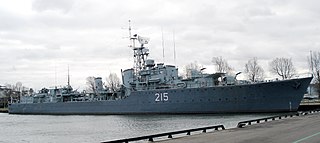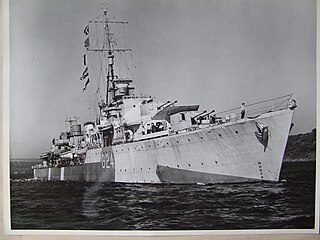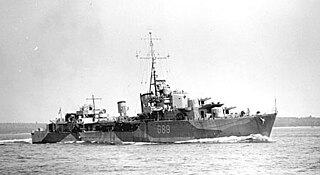Related Research Articles
Two ships of the Royal Australian Navy have been named HMAS Warramunga, after the Warumungu Aborigines.

Iroquois-class destroyers, also known as Tribal class or DDG 280 class, were a class of four helicopter-carrying, guided missile destroyers of the Royal Canadian Navy. The ships were named to honour the First Nations of Canada.

HMCS Haida is a Tribal-class destroyer that served in the Royal Canadian Navy (RCN) from 1943 to 1963, participating in World War II and the Korean War. She was named for the Haida people.
Several Canadian naval ships have been named HMCS Athabaskan. All named for the Athabaskan people and destroyers. First ship was British built, the other two in Canada.

HMCS Athabaskan was the first of three destroyers of the Royal Canadian Navy to bear this name. It was a destroyer of the Tribal class, that served in the Second World War. She was named for the First Nations peoples who make up the Athabaskan language group. She was torpedoed in the English Channel and sunk in 1944.

The Tribal class, or Afridi class, were a class of destroyers built for the Royal Navy, Royal Canadian Navy and Royal Australian Navy that saw service in World War II. Originally conceived during design studies for a light fleet cruiser, the Tribals evolved into fast, powerful destroyers, with greater emphasis on guns over torpedoes than previous destroyers, in response to new designs by Japan, Italy, and Germany. The Tribals were well admired by their crews and the public when they were in service due to their power, often becoming symbols of prestige while in service.
Several Canadian naval units have been named HMCS Nootka.
Four Canadian naval units have been named HMCS Ottawa.
Several Canadian naval units have been named HMCS Algonquin.

HMCS Algonquin was an Iroquois-class destroyer that served in the Royal Canadian Navy (RCN) from 1973 to 2015.

HMCS Iroquois was the lead ship of the Iroquois-class destroyers of the Royal Canadian Navy, also known as the Tribal class or the 280 class. The second vessel to carry the name, she carried the hull number DDG 280. Entering service in 1972 she was assigned to Maritime Forces Atlantic (MARLANT) and was homeported at CFB Halifax. Iroquois was deployed overseas for blockade and anti-terrorism duties, including participating in Operation Apollo in 2002–03. Taken out of service in 2014 and paid off in 2015, the ship is currently awaiting disposal.
Several Canadian naval units have been named HMCS Huron.

HMCS Huron was a Tribal-class destroyer that served in the Royal Canadian Navy in the Second World War and the Korean War. She was the first ship to bear this name, entering service in 1943. She was named for the Huron people. During the Second World War the vessel saw service in Operation Neptune in the Bay of Biscay and along the French coast in support of the invasion of Normandy and escorted convoys to the Soviet Union. Following the war, the ship was placed in reserve. The destroyer was activated in 1950 as a training ship, but with the onset of the Korean War, was modernized and deployed twice to Korea. Following the war, Huron reverted to a training ship and took part in Cold War-era North Atlantic Treaty Organization (NATO) naval exercises until being paid off for the final time in 1963 and broken up for scrap in 1965.

HMCS Iroquois was a Tribal-class destroyer that served in the Royal Canadian Navy during the Second World War and Korean War. She was named for the Iroquois First Nations. Iroquois was the first ship to bear this name and the first ship of the class to serve with the Royal Canadian Navy.

Vice Admiral Henry George DeWolf was a Canadian naval officer who was famous as the first commander of HMCS Haida during the Second World War.
Several Canadian naval units have been named HMCS Kootenay.
Three ships of the Royal Navy have borne the name HMS Crusader, after the participants in the Medieval Crusades:
Rear-Admiral William Moss Landymore, OBE, CD was a Canadian naval officer. Born in Brantford, Ontario, Landymore joined the Royal Canadian Navy in 1936, but spent much of early career training with the Royal Navy. During World War II, Landymore returned to the Royal Canadian Navy and served aboard destroyers in the Battle of the Atlantic, surviving two sinkings. By the end of the war Landymore had taken a series of positions in Ottawa before returning to destroyer command during the Korean War. He was promoted through the ranks eventually becoming the first Commander of Maritime Command. :andymore became embroiled in a public feud with the Minister of National Defence following the Unification of the Canadian Armed Forces and resigned as a result. He died at Halifax, Nova Scotia.

The Battle of the Audierne Bay was an engagement between German and Allied naval flotillas that took place on 23 August 1944, during World War II. Three Allied warships, which had already established control off the coast of Brittany and were lurking off Audierne south of the invested fortress of Brest, intercepted and sank eight German vessels of an armed convoy. This was the conclusion of Operation Kinetic; an allied plan to intercept shipping and hinder Germans besieged at Brest.